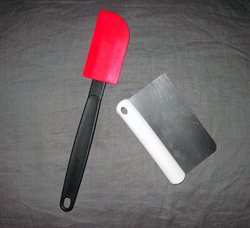
A spatula is a broad, flat, flexible blade used to mix, spread and lift material [1] including foods, drugs, plaster and paints.
Contents
- Use
- Kitchen use
- American English
- British English
- Non-regional
- Laboratory use
- Related utensils
- References
- External links
In medical applications, "spatula" may also be used synonymously with tongue depressor. [2]
The word spatula derives from the Latin word for a flat piece of wood or splint, a diminutive form of the Latin spatha , meaning 'broadsword', and hence can also refer to a tongue depressor. The words spade (digging tool) and spathe are similarly derived. The word spatula has been used in English since 1525. [3]


